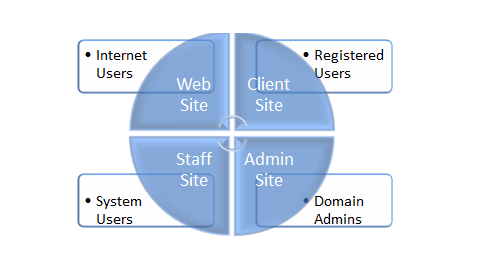Web Application for Online Services
The key focus during development of Famark has been 'People' while they are at home and also while they are at work. So the result is a technology that learns users instead of users learning it.
The platform is designed to connect and serve people both within and outside organizations.
For businesses that needs multiple website that are inter-connected with enterprise software and are aligned with business processes and policies; Famark provides a platform for developing separate website to cater to different user groups.
For example -
- You can have a public website for internet visitors,
- A site for registered users (or your customers) where they can sign in for service request or place orders,
- A site for your staff to review and act on service requests or orders, or interact with customers.
Further these websites can connect seamlessly with Customer Relationship Management (CRM) system implemented on Famark.
Interconnected Websites with CRM
Famark is a software platform that connects people both within and outside organization via web application designed as responsive website connected with CRM software and other business applications.
The following diagram shows typical types of sites (or dynamic websites) for different user groups and how they function as a complete CRM system within Famark platform –

What Famark provides?
A dynamic website requires server side programming for storing and retrieving data from database. However Famark eliminates the need for any such programming as actions such as creating, updating, deleting, retrieving, or importing and exporting data is auto-build by the platform.
Besides fulfilling server side programming requirements the platform also auto creates and facilitates designing web user interface. This is achieved by configuring sites in the Famark platform which can be one of the three types –
- Basic Site – It provides a standard user interface with familiar look and feel as default structure and styles are configured for the site. Such type of site is more suited for internal employees of the company whose requirements are to access information more efficiently.
- Custom Style – It provides the same standard structure as basic site however the default styles can be modified to change the look and feel. Such type of site is suited for registered users or internet users.
- Custom Web – For creating completely custom website on Famark platform that can still access Famark service for storing or retrieving data through JavaScript. This requires understanding of HTML5, CSS3 and JavaScript; however server side programming is still not required.
Note by virtue of default standard structures both Basic Sites and Custom Style Sites responsively adapts to the screen of the device from which it is being accessed, thus they support complete range of devices be it personal computers, tablets, notebooks or smartphones. In order to provide such compatibility with Custom Web Sites requires learning scripting and styling libraries designed for this purpose.
How to get started?
- Plan contents and functionalities for your sites.
- Register your domain at Famark and configure solution, entities and relation to store information. Famark System and Solutions guide provides details about configure system entities.
- Configure and customize your site. Famark Site, Handlers and Reports guide provides details about customizing default UI elements and configuring custom UI elements.
Join Famark Community!
Famark community is a social platform for creative and innovative professionals from different domains.
Join Community